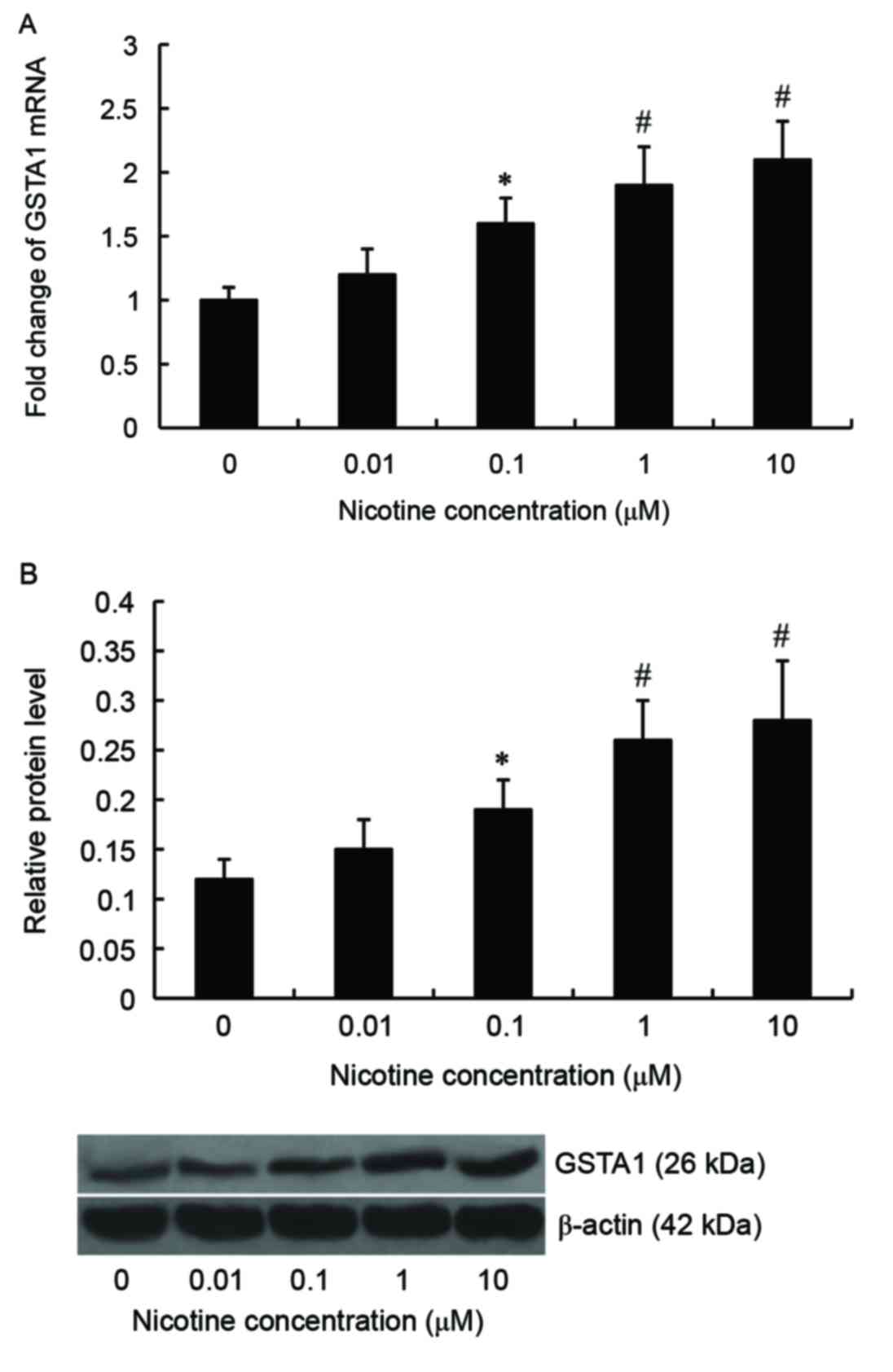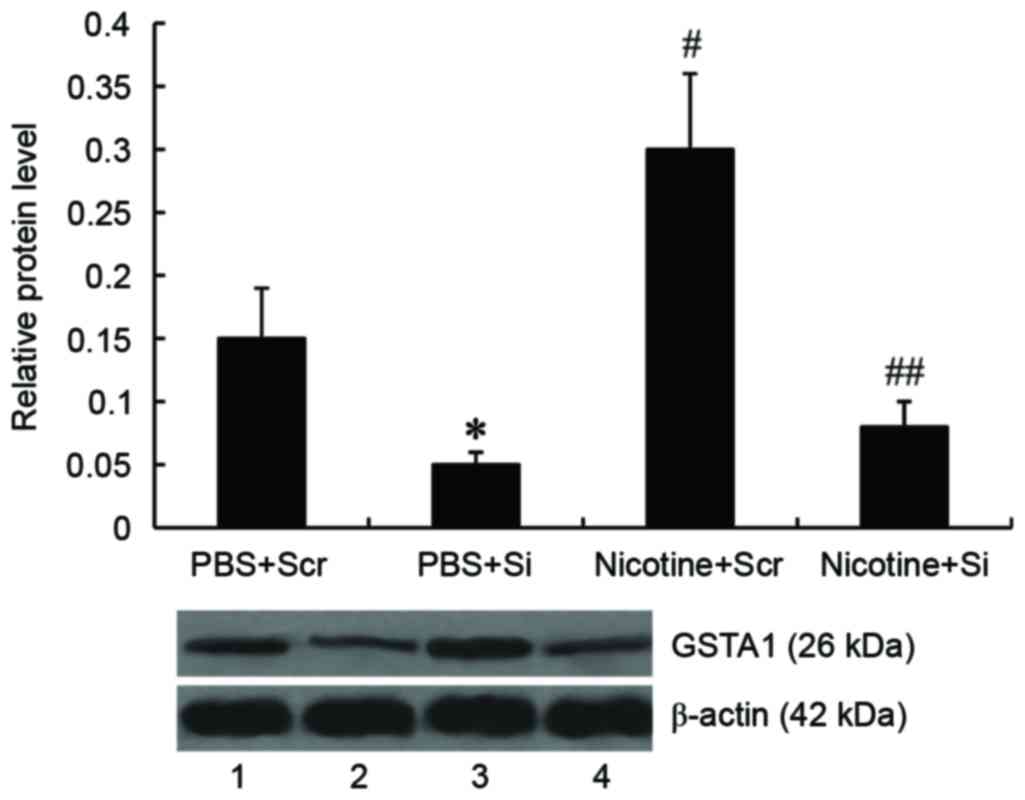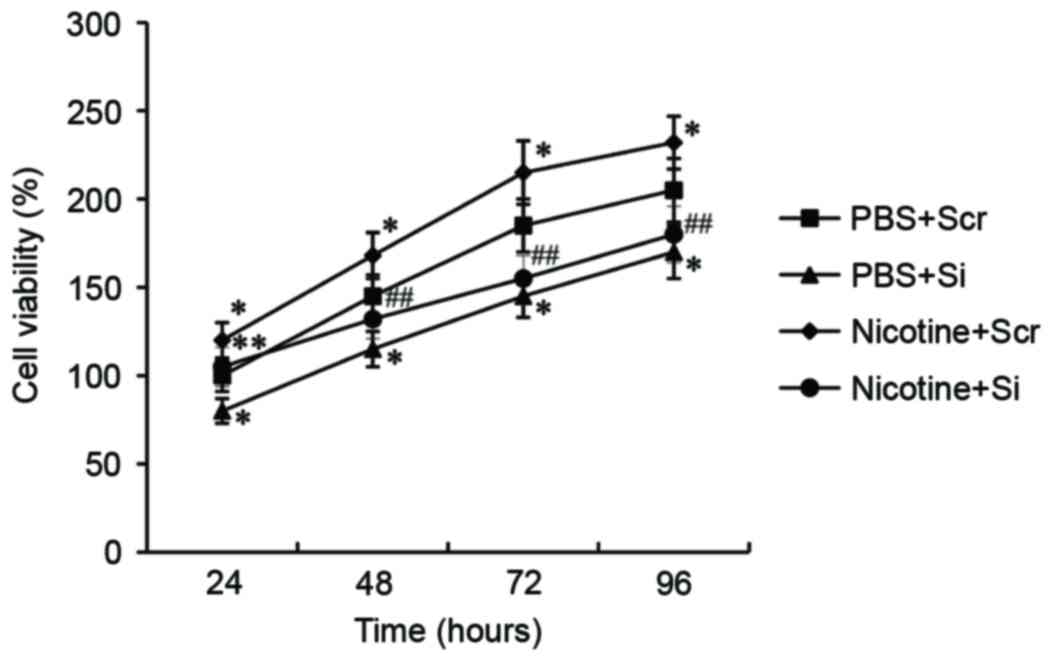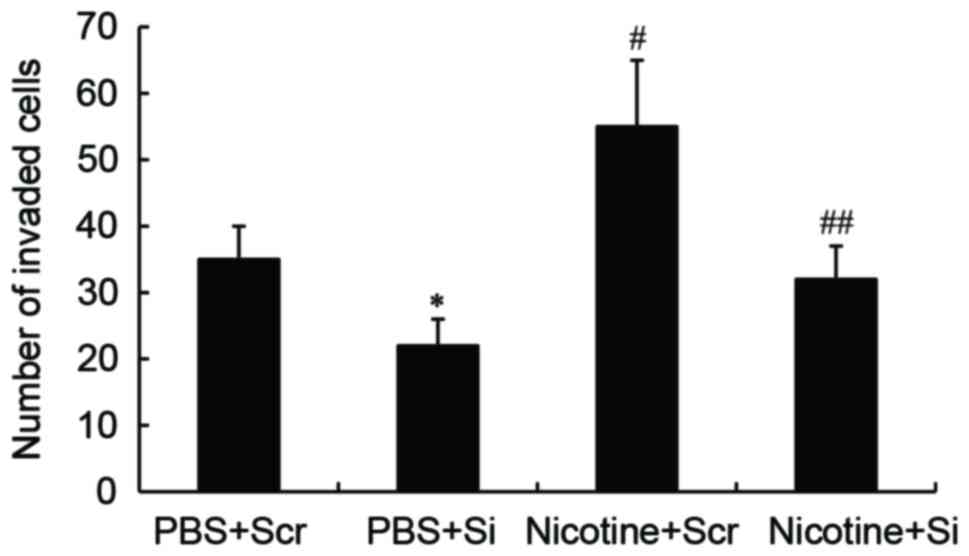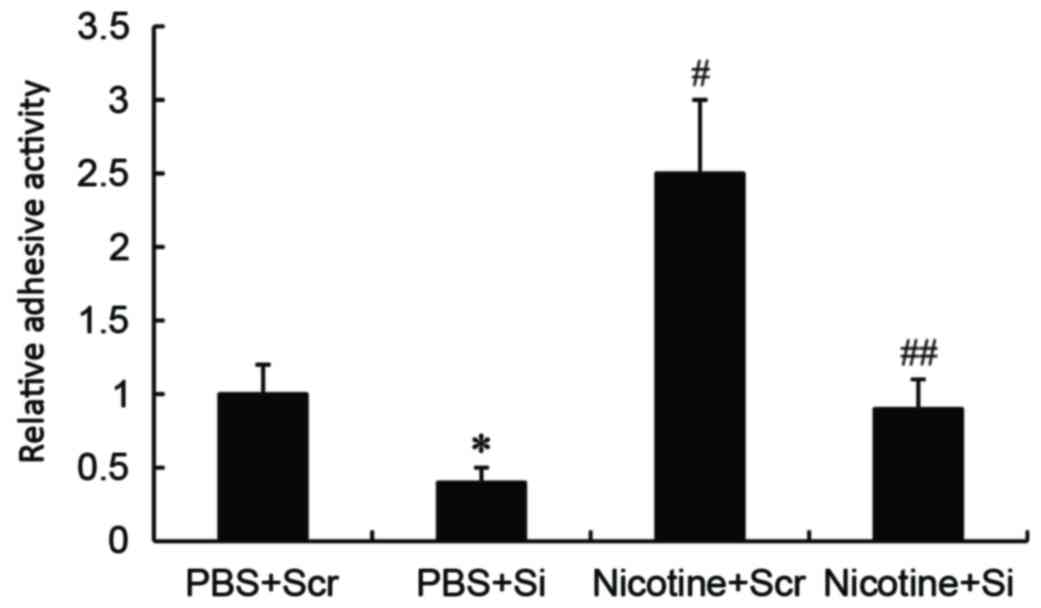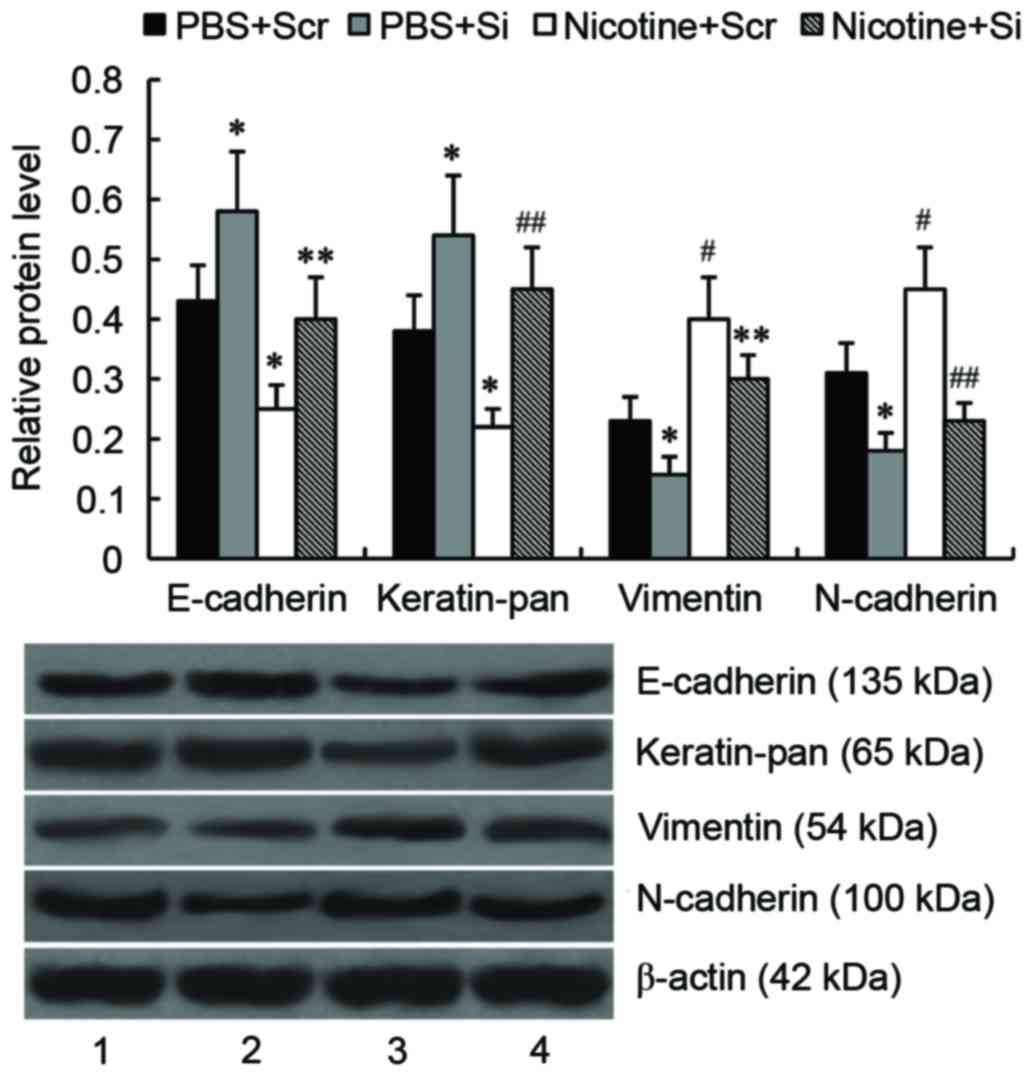|
1
|
Torre LA, Siegel RL and Jemal A: Lung
Cancer Statistics. Adv Exp Med Biol. 893:1–19. 2016. View Article : Google Scholar : PubMed/NCBI
|
|
2
|
Jemal A, Siegel R, Ward E, Hao Y, Xu J,
Murray T and Thun MJ: Cancer statistics, 2008. CA Cancer J Clin.
58:71–96. 2008. View Article : Google Scholar : PubMed/NCBI
|
|
3
|
Nguyen DX, Bos PD and Massagué J:
Metastasis: From dissemination to organ-specific colonization. Nat
Rev Cancer. 9:274–284. 2009. View
Article : Google Scholar : PubMed/NCBI
|
|
4
|
Steeg PS: Tumor metastasis: Mechanistic
insights and clinical challenges. Nat Med. 12:895–904. 2006.
View Article : Google Scholar : PubMed/NCBI
|
|
5
|
Chambers AF, Groom AC and MacDonald IC:
Dissemination and growth of cancer cells in metastatic sites. Nat
Rev Cancer. 2:563–572. 2002. View
Article : Google Scholar : PubMed/NCBI
|
|
6
|
Fidler IJ: The pathogenesis of cancer
metastasis: The ‘seed and soil’ hypothesis revisited. Nat Rev
Cancer. 3:453–458. 2003. View
Article : Google Scholar : PubMed/NCBI
|
|
7
|
Thiery JP: Epithelial-mesenchymal
transitions in tumour progression. Nat Rev Cancer. 2:442–454. 2002.
View Article : Google Scholar : PubMed/NCBI
|
|
8
|
Brabletz T, Hlubek F, Spaderna S,
Schmalhofer O, Hiendlmeyer E, Jung A and Kirchner T: Invasion and
metastasis in colorectal cancer: Epithelial-mesenchymal transition,
mesenchymal-epithelial transition, stem cells and beta-catenin.
Cells Tissues Organs. 179:56–65. 2005. View Article : Google Scholar : PubMed/NCBI
|
|
9
|
Hayes JD, Flanagan JU and Jowsey IR:
Glutathione transferases. Annu Rev Pharmacol Toxicol. 45:51–88.
2005. View Article : Google Scholar : PubMed/NCBI
|
|
10
|
Khan MS, Khan MK, Siddiqui MH and Arif JM:
An in vivo and in silico approach to elucidate the
tocotrienol-mediated fortification against infection and
inflammation induced alterations in antioxidant defense system. Eur
Rev Med Pharmacol Sci. 15:916–930. 2011.PubMed/NCBI
|
|
11
|
Lee WH, Morton RA, Epstein JI, Brooks JD,
Campbell PA, Bova GS, Hsieh WS, Isaacs WB and Nelson WG: Cytidine
methylation of regulatory sequences near the pi-class glutathione
S-transferase gene accompanies human prostatic carcinogenesis. Proc
Natl Acad Sci USA. 91:pp. 11733–11737. 1994; View Article : Google Scholar : PubMed/NCBI
|
|
12
|
Niu D, Zhang J, Ren Y, Feng H and Chen WN:
HBx genotype D represses GSTP1 expression and increases the
oxidative level and apoptosis in HepG2 cells. Mol Oncol. 3:67–76.
2009. View Article : Google Scholar : PubMed/NCBI
|
|
13
|
Zhang YJ, Chen Y, Ahsan H, Lunn RM, Chen
SY, Lee PH, Chen CJ and Santella RM: Silencing of glutathione
S-transferase P1 by promoter hypermethylation and its relationship
to environmental chemical carcinogens in hepatocellular carcinoma.
Cancer Lett. 221:135–143. 2005. View Article : Google Scholar : PubMed/NCBI
|
|
14
|
Reszka E, Wasowicz W and Gromadzinska J:
Genetic polymorphism of xenobiotic metabolising enzymes, diet and
cancer susceptibility. Br J Nutr. 96:609–619. 2006.PubMed/NCBI
|
|
15
|
Pan XD, Yang ZP, Tang QL, Peng T, Zhang
ZB, Zhou SG, Wang GX, He B and Zang LQ: Expression and function of
GSTA1 in lung cancer cells. Asian Pac J Cancer Prev. 15:8631–8635.
2014. View Article : Google Scholar : PubMed/NCBI
|
|
16
|
Hecht SS: Cigarette smoking: Cancer risks,
carcinogens, and mechanisms. Langenbecks Arch Surg. 391:603–613.
2006. View Article : Google Scholar : PubMed/NCBI
|
|
17
|
Guingab-Cagmat J, Bauzo RM, Bruijnzeel AW,
Wang KK, Gold MS and Kobeissy FH: Methods in tobacco abuse:
Proteomic changes following second-hand smoke exposure. Methods Mol
Biol. 829:329–348. 2012. View Article : Google Scholar : PubMed/NCBI
|
|
18
|
Davis R, Rizwani W, Banerjee S, Kovacs M,
Haura E, Coppola D and Chellappan S: Nicotine promotes tumor growth
and metastasis in mouse models of lung cancer. PLoS One.
4:e75242009. View Article : Google Scholar : PubMed/NCBI
|
|
19
|
Grozio A, Catassi A, Cavalieri Z, Paleari
L, Cesario A and Russo P: Nicotine, lung and cancer. Anticancer
Agents Med Chem. 7:461–466. 2007. View Article : Google Scholar : PubMed/NCBI
|
|
20
|
Cattaneo MG, Codignola A, Vicentini LM,
Clementi F and Sher E: Nicotine stimulates a serotonergic autocrine
loop in human small-cell lung carcinoma. Cancer Res. 53:5566–5568.
1993.PubMed/NCBI
|
|
21
|
Livak KJ and Schmittgen TD: Analysis of
relative gene expression data using real-time quantitative PCR and
the 2(−Delta Delta C(T)) Method. Methods. 25:402–408. 2001.
View Article : Google Scholar : PubMed/NCBI
|
|
22
|
Vos RM and Van Bladeren PJ: Glutathione
S-transferases in relation to their role in the biotransformation
of xenobiotics. Chem Biol Interact. 75:241–265. 1990. View Article : Google Scholar : PubMed/NCBI
|
|
23
|
Watson MA, Stewart RK, Smith GB, Massey TE
and Bell DA: Human glutathione S-transferase P1 polymorphisms:
Relationship to lung tissue enzyme activity and population
frequency distribution. Carcinogenesis. 19:275–280. 1998.
View Article : Google Scholar : PubMed/NCBI
|
|
24
|
Stoehlmacher J, Park DJ, Zhang W, Groshen
S, Tsao-Wei DD, Yu MC and Lenz HJ: Association between glutathione
S-transferase P1, T1, and M1 genetic polymorphism and survival of
patients with metastatic colorectal cancer. J Natl Cancer Inst.
94:936–942. 2002. View Article : Google Scholar : PubMed/NCBI
|
|
25
|
Howells RE, Dhar KK, Hoban PR, Jones PW,
Fryer AA, Redman CW and Strange RC: Association between
glutathione-S-transferase GSTP1 genotypes, GSTP1 over-expression,
and outcome in epithelial ovarian cancer. Int J Gynecol Cancer.
14:242–250. 2004. View Article : Google Scholar : PubMed/NCBI
|
|
26
|
Wenzlaff AS, Cote ML, Bock CH, Land SJ and
Schwartz AG: GSTM1, GSTT1 and GSTP1 polymorphisms, environmental
tobacco smoke exposure and risk of lung cancer among never smokers:
A population-based study. Carcinogenesis. 26:395–401. 2005.
View Article : Google Scholar : PubMed/NCBI
|
|
27
|
White DL, Li D, Nurgalieva Z and El-Serag
HB: Genetic variants of glutathione S-transferase as possible risk
factors for hepatocellular carcinoma: A HuGE systematic review and
meta-analysis. Am J Epidemiol. 167:377–389. 2008. View Article : Google Scholar : PubMed/NCBI
|
|
28
|
Kilburn L, Okcu MF, Wang T, Cao Y,
Renfro-Spelman A, Aldape KD, Gilbert MR and Bondy M: Glutathione
S-transferase polymorphisms are associated with survival in
anaplastic glioma patients. Cancer. 116:2242–2249. 2010.PubMed/NCBI
|
|
29
|
Sergentanis TN and Economopoulos KP: GSTT1
and GSTP1 polymorphisms and breast cancer risk: A meta-analysis.
Breast Cancer Res Treat. 121:195–202. 2010. View Article : Google Scholar : PubMed/NCBI
|
|
30
|
Xu Z, Zhu H, Luk JM, Wu D, Gu D, Gong W,
Tan Y, Zhou J, Tang J, Zhang Z, et al: Clinical significance of
SOD2 and GSTP1 gene polymorphisms in Chinese patients with gastric
cancer. Cancer. 118:5489–5496. 2012. View Article : Google Scholar : PubMed/NCBI
|
|
31
|
Sharma A, Patrick B, Li J, Sharma R,
Jeyabal PV, Reddy PM, Awasthi S and Awasthi YC: Glutathione
S-transferases as antioxidant enzymes: Small cell lung cancer (H69)
cells transfected with hGSTA1 resist doxorubicin-induced apoptosis.
Arch Biochem Biophys. 452:165–173. 2006. View Article : Google Scholar : PubMed/NCBI
|
|
32
|
Yang Y, Sharma R, Sharma A, Awasthi S and
Awasthi YC: Lipid peroxidation and cell cycle signaling:
4-hydroxynonenal, a key molecule in stress mediated signaling. Acta
Biochim Pol. 50:319–336. 2003.PubMed/NCBI
|
|
33
|
Cheng JZ, Singhal SS, Sharma A, Saini M,
Yang Y, Awasthi S, Zimniak P and Awasthi YC: Transfection of mGSTA4
in HL-60 cells protects against 4-hydroxynonenal-induced apoptosis
by inhibiting JNK-mediated signaling. Arch Biochem Biophys.
392:197–207. 2001. View Article : Google Scholar : PubMed/NCBI
|
|
34
|
Zhao T, Singhal SS, Piper JT, Cheng J,
Pandya U, Clark-Wronski J, Awasthi S and Awasthi YC: The role of
human glutathione S-transferases hGSTA1-1 and hGSTA2-2 in
protection against oxidative stress. Arch Biochem Biophys.
367:216–224. 1999. View Article : Google Scholar : PubMed/NCBI
|
|
35
|
Adnan H, Quach H, MacIntosh K, Antenos M
and Kirby GM: Low levels of GSTA1 expression are required for
Caco-2 cell proliferation. PLoS One. 7:e517392012. View Article : Google Scholar : PubMed/NCBI
|
|
36
|
Egleton RD, Brown KC and Dasgupta P:
Nicotinic acetylcholine receptors in cancer: Multiple roles in
proliferation and inhibition of apoptosis. Trends Pharmacol Sci.
29:151–158. 2008. View Article : Google Scholar : PubMed/NCBI
|
|
37
|
Dasgupta P, Rizwani W, Pillai S, Kinkade
R, Kovacs M, Rastogi S, Banerjee S, Carless M, Kim E, Coppola D, et
al: Nicotine induces cell proliferation, invasion and
epithelial-mesenchymal transition in a variety of human cancer cell
lines. Int J Cancer. 124:36–45. 2009. View Article : Google Scholar : PubMed/NCBI
|
|
38
|
Heeschen C, Jang JJ, Weis M, Pathak A,
Kaji S, Hu RS, Tsao PS, Johnson FL and Cooke JP: Nicotine
stimulates angiogenesis and promotes tumor growth and
atherosclerosis. Nat Med. 7:833–839. 2001. View Article : Google Scholar : PubMed/NCBI
|
|
39
|
Kalluri R and Weinberg RA: The basics of
epithelial-mesenchymal transition. J Clin Invest. 119:1420–1428.
2009. View
Article : Google Scholar : PubMed/NCBI
|
|
40
|
Lim J and Thiery JP:
Epithelial-mesenchymal transitions: Insights from development.
Development. 139:3471–3486. 2012. View Article : Google Scholar : PubMed/NCBI
|
|
41
|
Hay ED and Zuk A: Transformations between
epithelium and mesenchyme: Normal, pathological, and experimentally
induced. Am J Kidney Dis. 26:678–690. 1995. View Article : Google Scholar : PubMed/NCBI
|
|
42
|
Patel NA, Patel PS and Vora HH: Role of
PRL-3, Snail, Cytokeratin and Vimentin expression in epithelial
mesenchymal transition in breast carcinoma. Breast Dis. 35:113–127.
2015. View Article : Google Scholar : PubMed/NCBI
|
|
43
|
Zeisberg M and Neilson EG: Biomarkers for
epithelial-mesenchymal transitions. J Clin Invest. 119:1429–1437.
2009. View
Article : Google Scholar : PubMed/NCBI
|
|
44
|
Kokkinos MI, Wafai R, Wong MK, Newgreen
DF, Thompson EW and Waltham M: Vimentin and epithelial-mesenchymal
transition in human breast cancer-observations in vitro and in
vivo. Cells Tissues Organs. 185:191–203. 2007. View Article : Google Scholar : PubMed/NCBI
|



